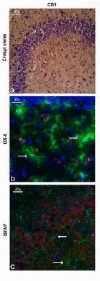Anti-inflammatory property of the cannabinoid agonist WIN-55212-2 in a rodent model of chronic brain inflammation
- PMID: 17178196
- PMCID: PMC1852513
- DOI: 10.1016/j.neuroscience.2006.11.016
Anti-inflammatory property of the cannabinoid agonist WIN-55212-2 in a rodent model of chronic brain inflammation
Abstract
Cannabinoid receptors (CBr) stimulation induces numerous central and peripheral effects. A growing interest in the beneficial properties of manipulating the endocannabinoid system has led to the possible involvement of CBr in the control of brain inflammation. In the present study we examined the effect of the CBr agonist, (R)-(+)-[2,3-dihydro-5-methyl-3-(4-morpholinylmethyl)-pyrrolo[1,2,3-de]-1,4benzoxazin-6-yl]-1-naphthalenyl-methanone mesylate (WIN-55212-2), on microglial activation and spatial memory performance, using a well-characterized animal model of chronic brain inflammation produced by the infusion of lipopolysaccharide (LPS, 250 ng/h for 3 weeks) into the fourth ventricle of young rats. WIN-55212-2 (0.5 or 1.0 mg/kg/day, i.p.) was administered for 3 weeks. During the third week of treatment, spatial memory ability was examined using the Morris water-maze task. We found that 0.5 and 1 mg/kg WIN-55212-2 reduced the number of LPS-activated microglia, while 1 mg/kg WIN-55212-2 potentiated the LPS-induced impairment of performance in the water maze task. Cannabinoid receptors 1 were not expressed by microglia and astrocytes, suggesting an indirect effect of WIN-55212-2 on microglia activation and memory impairment. Our results emphasize the potential use of CBr agonists in the regulation of inflammatory processes within the brain; this knowledge may lead to the use of CBr agonists in the treatment of neurodegenerative diseases associated with chronic neuroinflammation, such as Alzheimer disease.
Figures



Similar articles
-
Cannabinoids attenuate the effects of aging upon neuroinflammation and neurogenesis.Neurobiol Dis. 2009 May;34(2):300-7. doi: 10.1016/j.nbd.2009.01.014. Neurobiol Dis. 2009. PMID: 19385063
-
Cannabinoids ablate release of TNFalpha in rat microglial cells stimulated with lypopolysaccharide.Glia. 2003 Jan 15;41(2):161-8. doi: 10.1002/glia.10177. Glia. 2003. PMID: 12509806
-
Dysregulation of the endogenous cannabinoid system in adult rats prenatally treated with the cannabinoid agonist WIN 55,212-2.Eur J Pharmacol. 2007 Nov 14;573(1-3):11-9. doi: 10.1016/j.ejphar.2007.06.047. Epub 2007 Jul 4. Eur J Pharmacol. 2007. PMID: 17644084
-
Peroxisome proliferator-activated receptor agonist regulation of glial activation: relevance to CNS inflammatory disorders.Neurochem Int. 2006 Jul;49(2):183-9. doi: 10.1016/j.neuint.2006.04.003. Epub 2006 Jun 5. Neurochem Int. 2006. PMID: 16753239 Review.
-
LPS-induced Murine Neuroinflammation Model: Main Features and Suitability for Pre-clinical Assessment of Nutraceuticals.Curr Neuropharmacol. 2016;14(2):155-64. doi: 10.2174/1570159x14666151204122017. Curr Neuropharmacol. 2016. PMID: 26639457 Free PMC article. Review.
Cited by
-
The influence of cannabinoids on generic traits of neurodegeneration.Br J Pharmacol. 2014 Mar;171(6):1347-60. doi: 10.1111/bph.12492. Br J Pharmacol. 2014. PMID: 24172185 Free PMC article. Review.
-
Sex-dependent long-term effects of adolescent exposure to THC and/or MDMA on neuroinflammation and serotoninergic and cannabinoid systems in rats.Br J Pharmacol. 2014 Mar;171(6):1435-47. doi: 10.1111/bph.12519. Br J Pharmacol. 2014. PMID: 24236988 Free PMC article.
-
Region-Specific Impact of Repeated Synthetic Cannabinoid Exposure and Withdrawal on Endocannabinoid Signaling, Gliosis, and Inflammatory Markers in the Prefrontal Cortex and Hippocampus.Biomolecules. 2025 Mar 14;15(3):417. doi: 10.3390/biom15030417. Biomolecules. 2025. PMID: 40149953 Free PMC article.
-
Cannabinoid 1 Receptor Signaling on Hippocampal GABAergic Neurons Influences Microglial Activity.Front Mol Neurosci. 2018 Aug 28;11:295. doi: 10.3389/fnmol.2018.00295. eCollection 2018. Front Mol Neurosci. 2018. PMID: 30210289 Free PMC article.
-
The Neuroglial Dialog Between Cannabinoids and Hemichannels.Front Mol Neurosci. 2018 Mar 20;11:79. doi: 10.3389/fnmol.2018.00079. eCollection 2018. Front Mol Neurosci. 2018. PMID: 29662436 Free PMC article.
References
-
- Akiyama H, Barger S, Barnum S, Bradt B, Bauer J, Cooper NR, Eikelenboom P, Emmerling M, Fiebich B, Finch CE, Frautschy S, Griffin WST, Hampel H, Landreth G, McGeer PL, Mrak R, MacKenzie I, O’Banion K, Pachter J, Pasinetti G, Plata-Salaman C, Rogers J, Rydel R, Shen Y, Streit W, Strohmeyer R, Tooyoma I, Van Muiswinkel FL, Veerhuis R, Walker D, Webster S, Wegrzyniak B, Wenk G, Wyss-Coray A. Inflammation in Alzheimer’s disease. Neurobiol Aging. 2000;21:383–421. - PMC - PubMed
-
- Begg M, Pacher P, Batkai S, Osei-Hyiaman D, Offertaler L, Mo FM, Liu J, Kunos G. Evidence for novel cannabinoid receptors. Pharmacol Ther. 2005;2:133–145. - PubMed
-
- Castellano C, Rossi-Arnaud C, Cestari V, Costanzi M. Cannabinoids and memory: animal studies. Curr Drug Targets CNS Neurol Disord. 2003;2:389–402. - PubMed
Publication types
MeSH terms
Substances
Grants and funding
LinkOut - more resources
Full Text Sources
Other Literature Sources
Medical
Miscellaneous

